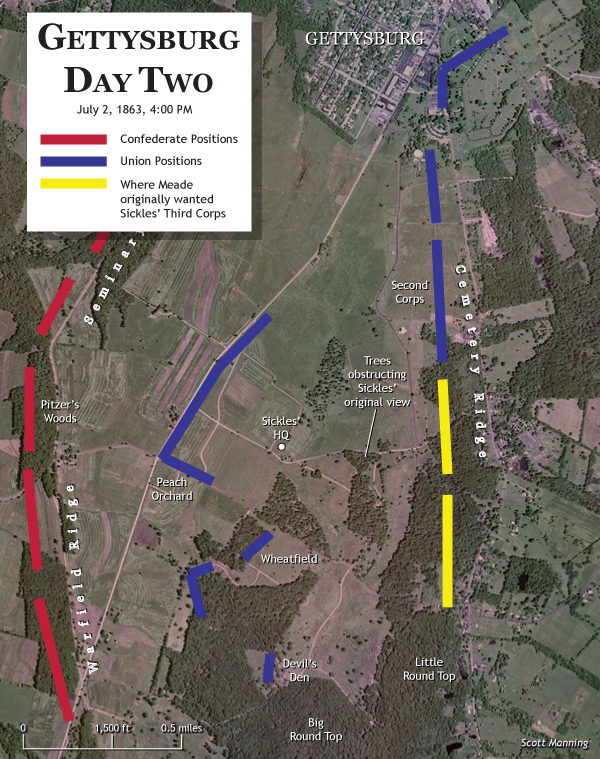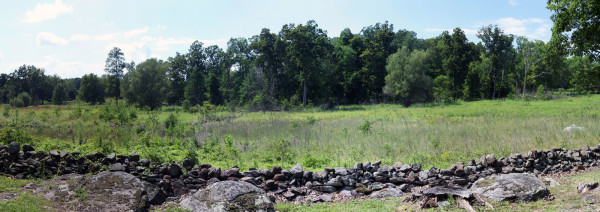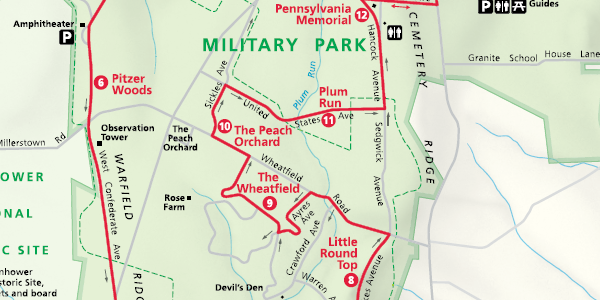Welcome to the first edition of Warpath Wednesday, the day in which I recount something historical from the warpath. Today’s focus is my absolute favorite spot at Gettysburg: Sedgwick Avenue.
First, I am an unlicensed tour guide of Gettysburg, which means I provide tours to friends, family, and coworkers for free. Want a professional? Then hire a pro like Phillip Muskett. Still, after three dozen rogue tours of Gettysburg, I’ve found what I think is one of the most significant yet neglected spots on the battlefield—Sedgwick Avenue.
You pass it heading north from Little Round Top on the way to Hancock Avenue and its string of massive monuments. If you stop your car halfway between Wheatfield Rd and United States Ave, you’ll find the spot I’m talking about, a spot most people drive right though. I did that the first half dozen times. If you get out of your car for whatever reason, you’ll likely feel irritated by the trees 130 yards to the west that block any useful view of the rest of the battlefield. And that’s exactly the point.
Another man was frustrated by this same view—General Daniel Sickles, who commanded the Third Corps of the Army of the Potomac. He was ordered to line up roughly where modern-day Sedgwick Avenue runs today (see the yellow lines in the map below). According to General Henry Hunt, Sickles thought his assigned line “was not a good one, especially that he could not use his artillery there.” ((Quoted in James A. Hessler, Sickles at Gettysburg: The Controversial Civil War General Who Committed Murder, Abandoned Little Round Top, and Declared Himself the Hero of Gettysburg (New York: Savas Beatie, 2010), 114.))

Thanks to the efforts by the National Park Service to restore the field to its 1863 incarnation, they have allowed these trees to grow in over the past decade in order to give us the same frustrating view Sickles had at roughly 7:00 AM on of July 2, 1863. With the trees obstructing his view, we can see why he concerned about being unable to use artillery.

While the photo does not do justice to the view an actual visit provides, notice how you can’t see the elevated Peach Orchard, Emmitsburg Road, or especially the Confederate line.
After much confusion and mismanagement on the morning of July 2, Sickles would redeploy his corps on spots such as Devil’s Den and the Peach Orchard, well in advance of the rest of the Union line (see the map above).
I am in 100% agreement with Licensed Battlefield Guide James A. Hessler that “Sickles’ advance, more than any individual action, dictated the flow of the fighting on Gettysburg’s second day and would also significantly impact the third day.” ((Hessler, Sickles at Gettysburg, 2010, 141.)) I think most historians—professional and rogue alike—would agree with Hessler.
With the ominous impact of Sickles’s decision to advance his corps, why wouldn’t we value Sedgwick Avenue and the view Sickles had when he did not like his position? The official map and guide brochure for Gettysburg does not include a stop. Even J. David Petruzzi’s The Complete Gettysburg Guide, which is frankly the best guide on the market, skips Sedgwick Avenue entirely. Both guides literally send visitors around Sedgwick Avenue.

As a result, it is secluded and rarely crowded, which is especially calming on a busy day when Little Round Top and Hancock Avenue are jammed with tour buses.
